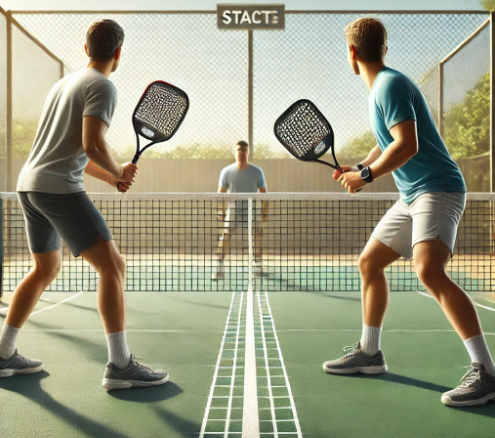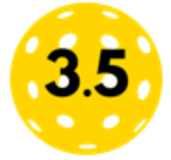
Defensive Stacking in Pickleball: Put Your Forehand in the Right Place
Defensive stacking in pickleball might not sound as exciting as nailing an Erne, but trust me, it’s just as crucial. This strategy positions a forehand in the center of the court, giving your team a solid defense against offensive third shots.
Why Use Defensive Stacking?
Without defensive stacking, the middle of the court becomes prime real estate for your opponents. This is especially true for teams with one right-handed and one left-handed player—without stacking, both players’ backhands end up in the middle, creating a weak spot. Advanced players love to exploit this gap with precise drop shots or blistering drives, leaving your team scrambling with awkward backhands and missed opportunities.
Defensive stacking ensures your forehands are ready to dominate the center. Here’s why it’s worth the effort:
- Neutralize Offensive Third Shots: A forehand in the middle is your best defense against those dreaded third-shot drops.
- Minimize Confusion: Stacking helps avoid those awkward “Was that yours?” moments during fast-paced rallies.
- Strengthen Defense: Perfect for mixed-handed teams (e.g., one right-handed, one left-handed), stacking optimizes your coverage and response time.
The Problem Without Defensive Stacking
See the illustration below, without stacking, after Player D returns the serve, there’s no forehand covering the middle of the court.

Without stacking, after Player D returns the serve, there’s no forehand covering the middle of the court.
Advanced opponents will quickly notice and exploit this weakness by targeting the center with drop shots or fast-paced returns.
This often forces backhand responses—which are harder to execute consistently—and can cause confusion about who should take the shot.
How to Execute Defensive Stacking
Defensive stacking sounds complicated, but it’s all about smooth transitions and clear communication. Here’s how it works:

Step 1: Start with the Right Setup
- Player C (Left-Handed): Begins just outside the court on the opposite side from their partner.
- Player D (Right-Handed): Prepares to return the serve.
Step 2: Move into Position
- After returning the serve, Player D moves up to the kitchen line position normally occupied by Player C.
- Simultaneously, Player C slides over to cover the middle.
Result: Both forehands are now in the center, perfectly positioned to counter the offensive third shot.
Challenges of Defensive Stacking
While effective, defensive stacking isn’t without its hiccups:
- Increased Movement: The returner has to hustle to get into position after the serve. When stacking the serve returner has to move diagonally and slightly further than without stacking. Without stacking, they move straight ahead.
- Coordination is Key: Both players must know their roles and transition seamlessly to avoid gaps.
- Timing Matters: Poorly executed switches can leave your team scrambling.
Practice Tips for Defensive Stacking
Want to stack like a pro? Here’s how to nail it:
- Start Small: Practice stacking in casual games to build confidence without the pressure of competition.
- Communicate Clearly: Always confirm who’s going where before the point starts.
- Refine Your Timing: Smooth transitions are critical—practice until it feels automatic.
Summary: Make Defensive Stacking Work for You
Defensive stacking in pickleball might require extra movement and coordination, but it’s a game-changer for teams aiming to hit the 3.5+ level.
Here’s why you should give it a shot:
- Neutralize Third Shots: A forehand in the middle gives you control over the center.
- Optimize Defense: Perfect for righty-lefty duos or any team looking to sharpen their edge.
- Stay Competitive: Advanced opponents will find it much harder to exploit your positioning.
Take the time to learn defensive stacking, and you’ll soon be shutting down third shots and controlling the court like a seasoned pro.
Check out Payton Bonds new eBook!
Pickleball Strategy – A Guide to 3.5 and Beyond
See it on Amazon.

👤 Follow Payton Bond
All Star and Top Contributor on multiple Facebook Pickleball Forums.
Contributor at TheKitchenPickle.com.
Visit Payton Bonds Facebook Page

